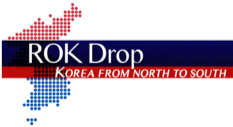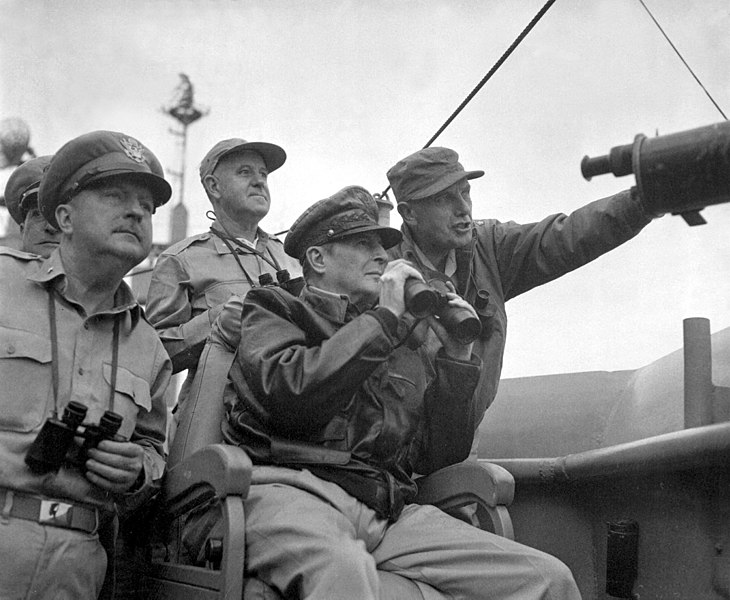The Inchon Landing: Operation Chromite
The Incheon Landing, code named “Operation Chromite” is quite possibly the most recognized action taken during the Korean War and what is most amazing about the operation is the fact that it happened at all. Just about every general in the Pentagon was against General MacArthur’s plan to invade Incheon because of the great danger involved in navigating Incheon’s infamous tidal flats. Everyone else was convinced that Kunsan or even Osan south of Incheon were better locations to launch an amphibious operation of this magnitude. MacArthur knew that this is where the North Koreans would expect the UN forces to land and the North Korean were in fact making preparations for landings in these areas because they believed no one was foolish enough to try and land at Incheon. Well no one accept General MacArthur.
MacArthur convinced the Secretary of Defense that his plan was the right course of action and eventually using has famous flare and prestige MacArthur was able to convince the Joint Chief’s of Staff and President Harry Truman to sign off on his plan. However, visions of landing crafts trapped in the Incheon mud which would be sitting ducks for the North Korean artillery raced through everyones minds.
Fortunately the successful “Operation Trudy Jackson” put those fears to rest. The operation allowed General MacArthur’s armada of ships containing the newly constituted X Corps and associated combat power to safely navigate the treacherous Incheon Bay the night of September 14, 1950. The bright light of the Palmi-do lighthouse proved to be a critical navigational aid for the sailors involved with the landing.
Lt. Eugene Clark’s successful intelligence gathering also allowed General MacArthur to gain much needed knowledge about the enemy’s strong points and weaknesses. However, General MacArthur had one weakness himself. The X Corps that would carry out the operation was highly inexperienced. The X Corps commanded by MacArthur’s close friend and advisor Major General Edmond Almond was created specifically for the invasion of Incheon and featured many troops with no combat experience.

Two of the three Marine regiments that composed the 1st Marine Division involved in the operation had no combat experience. In fact the 1st Marine Regiment of the 1st Marine Division was activated in August and staged in Japan preparing for the invasion and the 7th Marine Regiment was activated on the 1st of September before deploying to fight at Incheon. Both of these regiments were filled with replacements from state side school houses, half of them were from the US Marine Reserve, and Marines transferred from the Mediterranean. The 5th Marine Regiment of the 1st Marine Division on the other hand were battle hardened Marines who fought in ferocious battles along the Naktong River Line during the Pusan Perimeter defense. They were the only unit in the X Corps with combat experience.
The 7th Infantry Division which was the Army’s contribution to the invasion was in worse shape than the Marines. They were the division responsible for occupation duty in Japan. However, as the war raged on in Korea the division was stripped for replacement soldiers in Korea. In August of 1950 the 7th Division was at approximately half strength. By channeling all infantry and artillery replacements into the 7th Division and transferring 8,000 ROK Army KATUSA trainees from Pusan to join the 7th Division in Japan, the division was able to near 100% strength by September.
However, these 8,000 KATUSA soldiers were merely nothing more than poor Korean boys taken from the refugee camps of Pusan for KATUSA training before being picked up for the Incheon invasion. They had not received any English or military training before leaving for Japan. Many of the KATUSAs in fact wore only shorts and sandals when they reported to their respective units in Japan.
To say the US invasion force lacked experience was an understatement but they did have numbers because X Corps when it was all said and done was composed of over 70,000 soldiers. MacArthur however, would rely heavily on the battle hardened 5th Marine Regiment to spearhead the landing at Incheon.

For two days prior to the landing the North Korean positions had been bombed repeatedly by US naval and air power. At 6:30AM on September 15, 1950 Marines from the battle hardened 5th Marine Regiment with nine Pershing tanks landed on Green Beach on Wolmi-do Island. The island sat in the middle of the harbor and had to be secured before the remaining invasion force could land at Incheon proper. The Marines secured the island in one and a half hours and killed or captured 400 North Korean soldiers while only suffering 17 wounded themselves.
However, the tide receded by 8:30AM and the invasion fleet had to retreat or risk being stuck in the mud flats. The Marines on Wolmi-do had to hold the island from an enemy counter attack along the tidal barrier connecting the island to the mainland until the tide rose again and more troops could land. The Marines held the island until 5:32PM when the tide rose again and the remaining Marines from the 1st Marine Division stormed Red Beach to the North and Blue Beach to the south of Wolmi-do, crushing the enemy resistance in the city of Incheon.
A picture of a Marine climbing a 15 foot high tidal barriers with a ladder while being shot at by North Koreans hiding in buildings over looking his position became the iconic image of the landing .

There had been no such amphibous landing during World War II into a city like what was being attempted now. Also during this time of combat in the streets of Incheon the Pershing tanks and Marines on Wolmi-do began to cross the tidal barrier to enter Incheon and also engage the overwhelmed North Koreans.

By 0130 on 16 September, 1950 the Marines had secured all their objectives in Incheon and allowed the ROK Special Marines to enter the city and mop up any remaining enemy forces, which they did with great brutality. Overall the X Corps had only 20 men killed, 174 wounded, and one MIA in taking Incheon. It was truly a brilliant amphibious operation constructed by General MacArthur.
The harbor was secured and the remainder of the X Corps, mostly the 7th Division, unloaded their equipment and men and began the march to capture Seoul. By September 26, 1950 Seoul was in UN forces hands and the North Korean supply lines had been effectively cut to their forces in the south. The 8th Army units at the Pusan perimeter mounted an offensive against the North Koreans and quickly the North Korean units were crushed by MacArthur’s hammer and anvil tactic. The North Koreans would never recover from this major defeat until the Chinese entered the war. But that is a story for another posting.
Information about the Incheon Landing was provided by the Kmike.com website and the book, This Kind of War by T.R. Fehrenbach.



[…] As the fighting in Korea escalated and the United Nations put out a call to arms from it’s members to defend Korea, the Canadian government began to seek volunteers for what they called the Canadian Army Special Force (CASF) and was to be commanded by Brigadier General J.M. Rockingham. The CASF was to be composed of a full combat brigade of soldiers and it was going to take a few months to raise and train that many soldiers to fight in Korea. While the force was being formed the Canadian government had cargo planes from the Royal Canadian Air Force (RCAF) begin transport duty for the UN forces between Ft. Lewis, Washington State and Haneda Airfield in Japan. Ft. Lewis was the major dispatch point of troops and supplies to fight in Korea. The RCAF contributed a total of 22 planes to help transport the needed supplies into the combat theatre. Additionally the Canadian government dispatched three naval destroyers to Korea. The destroyers arrived in July 1950 and would later serve during the September 1950 Inchon Landing Operation. […]
Very interesting series of posts – good stuff. And "This Kind of War" is an excellent book as well.
[…] you just imagine what would have happened if the timing of General MacArthur’s fleet that invaded Incheon during the Korean War was off? It would have been a slaughter with MacArthur’s boats all […]
[…] the success of the Incheon Landing Operation US and ROK forces on the Pusan Perimeter moved north to recapture land previously occupied by the […]
[…] ROK soldiers board ships in preparation for General MacArthur’s Incheon Landing Operation: […]
[…] It would have been a great opportunity to promote the US-ROK alliance with such a joint mock operation to honor the veterans of the Incheon Landing Operation. […]
[…] honor of the 58th anniversary of General Douglas MacArthur’s Incheon Landing Operation, I have decided to post pictures taking during the operation that were never before seen until they […]
[…] assault, 9/14/50 http://www.rt66.com/~korteng/SmallArms/wolmi1.htm • Found on Ask.com The Inchon Landing: Operation Chromite At 6:30AM on September 15, 1950 Marines from the battle hardened 5th Marine Regiment with nine […]
you guys used the wrong word.It’s except not “accept” 😐
The success of Incheon is and remains a myth. It pays to read the actual mission statement MacArthur issued to X Corps and Eighth US Army. The mission statement directed X Corps to land at Incheon and, in cooperation with Eighth U.S. Army, destroy the North Korean People’s Army south of the 38th parallel before the onset of winter. This did not happen. The NKPA was not destroyed, which is why MacArthur had to invade North Korea. There were excellent reasons not to land at Incheon. This is why all of MacArthur’s significant subordinates opposed the landing. I strongly recommend that people read Bruce Blair’s monumental study of command and leadership in Korean War. He was the first one with enough courage to expose the myth of Incheon. Perhaps if the landing had been made at Kunsan as most of MacArthur’s subordinates preferred, the NKPA would have been destroyed. In my view, Incheon is just the first of numerous strategic blunders MacArthur made in Korea. After Incheon, his next blunder was Wonsan. It was wrong to give a 72 year old man command authority in 1950. It would be considered unthinkable today.
If MacArthur was born 26 January 1880, he was seventy years old, not seventy-two in 1950. But he was past retirement age, that’s true. As to the more interesting question, what’s the best place for an amphibious attack, I have no idea. Maybe commenters who actually understand this stuff would like to offer their opinions.
Here’s the Wikipedia article on MacArthur.
We Will Remember Them.